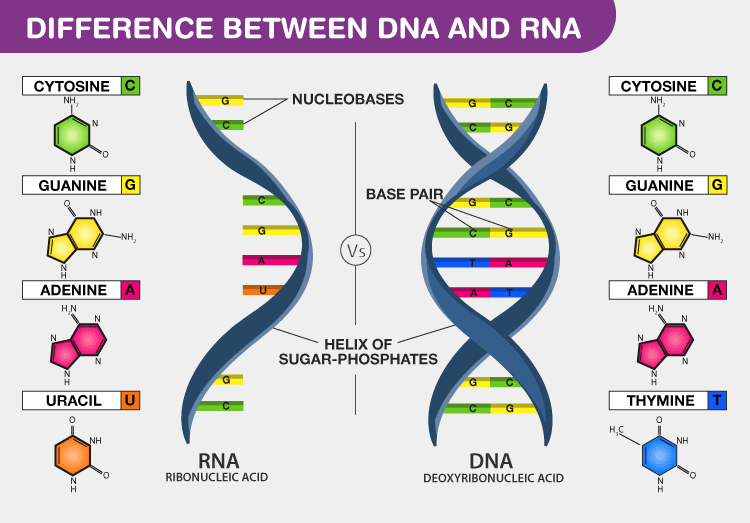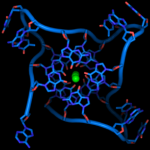
DNA stands for deoxyribonucleic acid, while RNA is ribonucleic acid. Although DNA and RNA both carry genetic information, there are quite a few differences between them. This is a comparison of the differences between DNA versus RNA, including a quick summary and a detailed table of the differences.
Summary of Differences Between DNA and RNA
- DNA contains the sugar deoxyribose, while RNA contains the sugar ribose. The only difference between ribose and deoxyribose is that ribose has one more -OH group than deoxyribose, which has -H attached to the second (2′) carbon in the ring.
- DNA is a double-stranded molecule, while RNA is a single-stranded molecule.
- DNA is stable under alkaline conditions, while RNA is not stable.
- DNA and RNA perform different functions in humans. DNA is responsible for storing and transferring genetic information, while RNA directly codes for amino acids and acts as a messenger between DNA and ribosomes to make proteins.
- DNA and RNA base pairing is slightly different since DNA uses the bases adenine, thymine, cytosine, and guanine; RNA uses adenine, uracil, cytosine, and guanine. Uracil differs from thymine in that it lacks a methyl group on its ring.
Comparison of DNA and RNA
While both DNA and RNA are used to store genetic information, there are clear differences between them. This table summarizes the key points:
| Main Differences Between DNA and RNA | ||
| Comparison | DNA | RNA |
| Name | DeoxyriboNucleic Acid | RiboNucleic Acid |
| Function | Long-term storage of genetic information; transmission of genetic information to make other cells and new organisms. | Used to transfer the genetic code from the nucleus to the ribosomes to make proteins. RNA is used to transmit genetic information in some organisms and may have been the molecule used to store genetic blueprints in primitive organisms. |
| Structural Features | B-form double helix. DNA is a double-stranded molecule consisting of a long chain of nucleotides. | A-form helix. RNA usually is a single-strand helix consisting of shorter chains of nucleotides. |
| Composition of Bases and Sugars | deoxyribose sugar phosphate backbone adenine, guanine, cytosine, thymine bases | ribose sugar phosphate backbone adenine, guanine, cytosine, uracil bases |
| Propagation | DNA is self-replicating. | RNA is synthesized from DNA on an as-needed basis. |
| Base Pairing | AT (adenine-thymine) GC (guanine-cytosine) | AU (adenine-uracil) GC (guanine-cytosine) |
| Reactivity | The C-H bonds in DNA make it fairly stable, plus the body destroys enzymes that would attack DNA. The small grooves in the helix also serve as protection, providing minimal space for enzymes to attach. | The O-H bond in the ribose of RNA makes the molecule more reactive, compared with DNA. RNA is not stable under alkaline conditions, plus the large grooves in the molecule make it susceptible to enzyme attack. RNA is constantly produced, used, degraded, and recycled. |
| Ultraviolet Damage | DNA is susceptible to UV damage. | Compared with DNA, RNA is relatively resistant to UV damage. |
Unusual DNA and RNA
While the most common form of DNA is a double helix. there is evidence for rare cases of branched DNA, quadruplex DNA, and molecules made from triple strands.Scientists have found DNA in which arsenic substitutes for phosphorus.
Double-stranded RNA (dsRNA) sometimes occurs. It is similar to DNA, except thymine is replaced by uracil. This type of RNA is found in some viruses. When these viruses infect eukaryotic cells, the dsRNA can interfere with normal RNA function and stimulate an interferon response. Circular single-strand RNA (circRNA) has been found in both animals and plants.At present, the function of this type of RNA is unknown.



Comments are closed